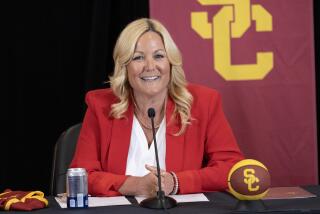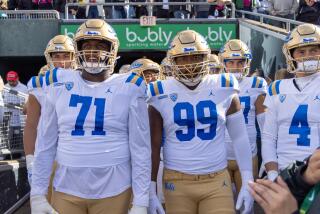The NCAA is bracing for a long, hot summer
Summer blockbusters are not just about movies anymore. This, in fact, could be the summer in which college athletics gets its Cecil B. DeMille close-up.
Several important issues are front and center, from the outcomes of Northwestern unionization to the pending student-athlete licensing case pitting Ed O’Bannon against the NCAA.
I shared a press room dinner with Mountain West Conference Commissioner Craig Thompson at last month’s NCAA West Regional at Honda Center. Thompson said the college landscape is changing so fast he hasn’t been able to take vacation for years. And let’s just say he isn’t booking a getaway to the Cayman Islands this summer.
Coaches and officials from the Mountain West, Pac-12, Big 12 and Mid-American conferences are meeting in Phoenix this week to discuss a myriad issues.
One item that caught my eye is the unfolding story of providing an additional “full cost of attendance” stipend for student-athletes.
This is going to happen. The big five conferences--Pac 12, SEC, Big 12, Big Ten and ACC--are basically drafting a mini-secession plan from the NCAA so they can distribute their disproportionate share of broadcast money any old (or new) way they want.
This will further separate the “have” from the “have nots” but it was bound to happen.
The question is how schools and conferences will determine “full cost of attendance.” How much will schools outside the power five be able to afford? How do Pell Grants for lower-income students affect the actual cost of attendance?
“I don’t think anybody knows exactly how it’s going to work,” Kansas State football Coach Bill Snyder told Jon Solomon of CBSSports.com.
Solomon cited a 2012 survey in which actual cost of attendance at major colleges ranged from $1,000 to $6,904 per year, with the NCAA average at roughly $3,500.
It will likely be left to individual schools to determine the dollar amount but that amount could affect everything from recruiting to athletic department staffing.
It logically follows that all students, not just those from revenue-producing men’s sports, would have to be compensated. And landmark Title IX legislation would certainly seem to have women athletes covered in the discussion.
What a mess and what upheaval, but you know what they say: change is never easy.
No wonder NCAA President Mark Emmert’s hair is growing grayer every day.
More to Read
Go beyond the scoreboard
Get the latest on L.A.'s teams in the daily Sports Report newsletter.
You may occasionally receive promotional content from the Los Angeles Times.











